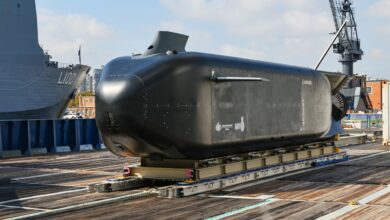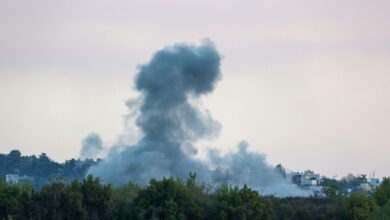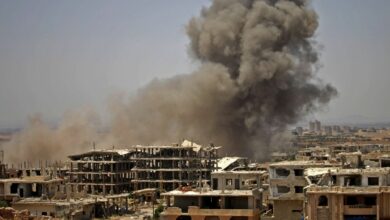Intelligence ‘ambiguity’ raises questions over ISIS capability in Iraq and Syria, US-led Coalition says
That ISIS did not exploit Iraq protests raises doubts over its capabilities, senior commander says
The U.S.-led Coalition against Islamic State has reduced its joint military operations with the Iraqi Army and the U.S. withdrew nearly 2,000 troops out of Syria, but ISIS has not rebounded to control territory, according to a senior CJTF-OIR commander.
That, said U.S. Air Force Major General Alexus Grynkewich, Operation Inherent Resolve’s Deputy Commander – Operations and Intelligence, may be a cause for optimism.
The Coalition is monitoring the group’s activities with bated breath, months into anti-government protests that have swept across Iraq, and after Turkey invaded northeast Syria, developments which have threatened to upend the security situations in territories recaptured from ISIS.
Though the group still claims frequent attacks, ISIS has largely gone underground in Iraq and Syria since its territorial defeat and the death of its leader, Abu Bakr al-Baghdadi, in a U.S. special forces raid last year.
“There’s a bit of ambiguity as you look at the intelligence,” Grynkewich told reporters at the Pentagon on Wednesday, January 22.
The Coalition, Grynkewich said, has “been trying to determine … Is ISIS executing some sort of strategic patience, waiting for an opportunity that they can exploit? Or are they truly on the ropes a bit more, and lacking in capability and capacity?”
The U.S. has long feared that political instability in territories captured from ISIS could lead to the group’s resurgence. But widespread protests across Iraq since October have not led to a significant increase in ISIS attacks, Grynkewich said, noting that U.S. forces have come under more attacks from Iran-linked groups in recent months.
The Coalition suspended training and some joint operations with the Iraqi Security Forces after a U.S. drone strike killed Iranian Major General Qassem Soleimani in Baghdad.
Iraq’s parliament voted to oust U.S. forces from the country following the strike, raising fears that ISIS might exploit any potential American withdrawal.
Still, the group has not “exploited any gaps or seams that may have arisen” due to the scale-back of operations in Iraq, the deputy commander said. That has led the Coalition to believe the lack of ISIS attacks may be due more to its weakened organizational capabilities rather than strategic patience.
Surveillance and combat flights have continued, and the U.S. still maintains its advisory role with Iraqi partner forces at the operational and tactical levels, but full cooperation isn’t set to resume until the two countries’ political leaders decide to do so, Grynkewich said.
‘By, with and through’ local forces
The U.S. opted in 2014 to work “by, with and through” local forces in Iraq and Syria to defeat ISIS on the ground. The aim was to minimize the U.S. footprint – and casualties – in the region, and leave a competent stabilization force in place for when American troops withdraw.
While it is too early to judge the long-term success of the approach, the Coalition is beginning to interpret ISIS’s relative inactivity positively, Grynkewich suggested.
The Coalition and allied Syrian Democratic Forces, an alliance of local militias led by the predominantly-Kurdish YPG, captured ISIS’s final territory near the Iraq border in March 2019.
Then in October, Baghdadi was killed in a U.S. special forces raid in northwest Syria.
Although ISIS quickly named Baghdadi’s successor, Grynkewich said he believes the group’s future successes likely won’t be determined by whatever military tact or charisma new leader Abu Ibrahim al-Hashimi al-Qurayshi may have, but rather will depend on the group’s resources, logistics and organizational capacities.
Though huge strides have been made in disrupting those capabilities, the U.S. military says there is more work to do to prevent ISIS from returning.
Targeted counter-ISIS raids and training with the SDF have continued in Syria, even after interruptions caused by Turkey’s geographically limited Operation Peace Spring ground offensive against the SDF that began in October.
Turkey considers the People’s Protection Units (YPG), the backbone of the SDF, to be a terrorist organization and has repeatedly criticized the U.S. for backing the group.
The incursion led to reported escapes by ISIS-affiliated prisoners held in SDF custody. There are some 10,000 ISIS prisoners in northeast Syria, Grynkewich said earlier on Wednesday, though so far no attempted jailbreaks by ISIS itself have proven successful.
“But we’re definitely keeping a close eye on it,” the general said.
Just over 500 U.S. troops remain on the ground in northeast Syria, Grynkewich said, down from more than 2,000 in December 2018, a result of repeated orders from President Donald Trump to withdraw.
U.S. special forces have since pulled back from parts of northeast Syria to patrol local strategic oilfields which benefit the SDF, U.S. defense officials and northeast Syrian representatives have said.
Even if the U.S. forces were ordered out of Iraq, their presence in Syria could still be supplied and sustained – and vice versa, Grynkewich said. “There’s always a way … depending on how many resources you’re willing to commit.”
But that is not the Pentagon’s ideal situation. “Being in Syria absolutely helps contribute to the stability of Iraq,” he said.
The Trump administration has signaled its intent to keep its forces in Iraq and Syria for the time being.
“ISIS does certainly still remain a threat,” Grynkewich said, emphasizing that the group still has “the potential to resurge” if joint operations are paused for too long.
Still, he said, “I don’t think it’s an immediate threat of an immediate resurgence.”












